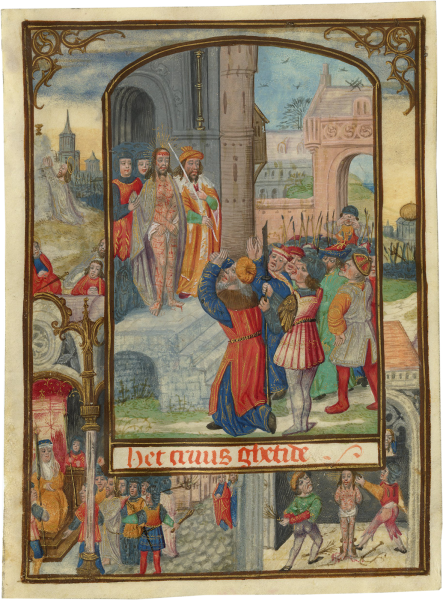Masters of Raphael de Mercatellis Throne of Mercy



Masters of Raphaël de Mercatellis
, Southern Netherlands, Ghent or Bruges, c. 1500–1510
Masters of Raphaël de Mercatellis
Description
This large miniature depicting the Trinity was created by the Masters of Raphaël de Mercatellis, a prolific workshop responsible for some of the most celebrated illuminations in the Low Countries at the turn of the fifteenth century. Set in a luminous gold field, the bright blue initial ‘B’ frames the Holy Trinity in a composition known as the Throne of Mercy (Gnadenstuhl). God the Father sits on his heavenly throne holding upright the crucified Christ while a dove representing the Holy Spirit perches at the top of the cross, wings aloft. The leaf is embellished with bright yellow borders decorated with strewn flowers and spiraling tree branches. Originating from an unknown Antiphonary, the initial ‘B’ opens the first responsory of the first nocturn of Matins on Trinity Sunday: Benedicat nos Deus, Deus noster, benedicat nos Deus (May God, our God, bless us). The recto contains further antiphons and psalms for the first nocturn, with musical notation on four-line staves in red.
The Masters of Raphaël de Mercatellis comprised a collective of anonymous miniaturists active around 1470–1510, probably in different workshops in Ghent and Bruges. They are so-named for their most notable patron Raphaël de Mercatellis (1437–1508), an illegitimate son of Philip the Good of Burgundy who served as abbot of Saint Bavo in Ghent and became the most important humanistic bibliophile in the Low Countries. However, the workshop also executed famous commissions for many other illustrious clients such as the Missal of Jan van Broedere (d. 1526), an abbot and humanist scholar of Geraardsbergen Abbey.
Stylistic similarities, such as the rendering of figures and treatment of cloth, suggest that this miniature was executed by one or more of the artists responsible for the Trinity depicted in a copy of Jean Gerson’s Monotessaron, painted by the workshop for Mercatellis around 1504 (fig. 1, Ghent, University Library, Ms. 11, f. 5v). The border motif of a tree with white and yellow spiraling branches also appears in several manuscripts illuminated by the Mercatellis group as well as contemporaries including the Hours painted in Bruges around 1510–1519 by Cornelia van Wulfschkercke (Brussels, KBR, Ms. IV 104, f. 203v) and the Hours painted in Bruges in the style of the Master of the Prayer Books of around 1500 (fig. 2, Baltimore, Walters Art Museum, Ms. W.178, f. 130v). The pen-flourishing on our initial is unique and thus far unknown to the Mercatellis group. The pigments and parchment are in good condition, with some isolated smudges on the edges and margins.
We are grateful to Anne Margreet As-Vijvers for expertise.
Literature:
Unpublished; for comparisons and further reading, see:
Arnould, A. “The Iconographical Sources of a Composite Manuscript from the Library of Raphael de Mercatellis,” Journal of the Warburg and Courtauld Institutes 51 (1988), pp. 197–209.
Bergen W. van. “Two identical manuscripts from the library of Raphael de Mercatellis? The relationship between MSS 11 and 17 in the University Library of Ghent,” Quaerendo 41 (2010), pp. 1–10.
Derolez, A. The Library of Raphael de Mercatellis, Ghent, 1979.
Dogaer, G. Flemish miniature painting in the 15th and 16th centuries, Amsterdam, 1987, pp. 151–155.
Wijsman, H. Luxury Bound: Illustrated Manuscript Production and Noble and Princely Book Ownership in the Burgundian Netherlands (1400–1550), Turnhout, 2010, pp. 282–283.
